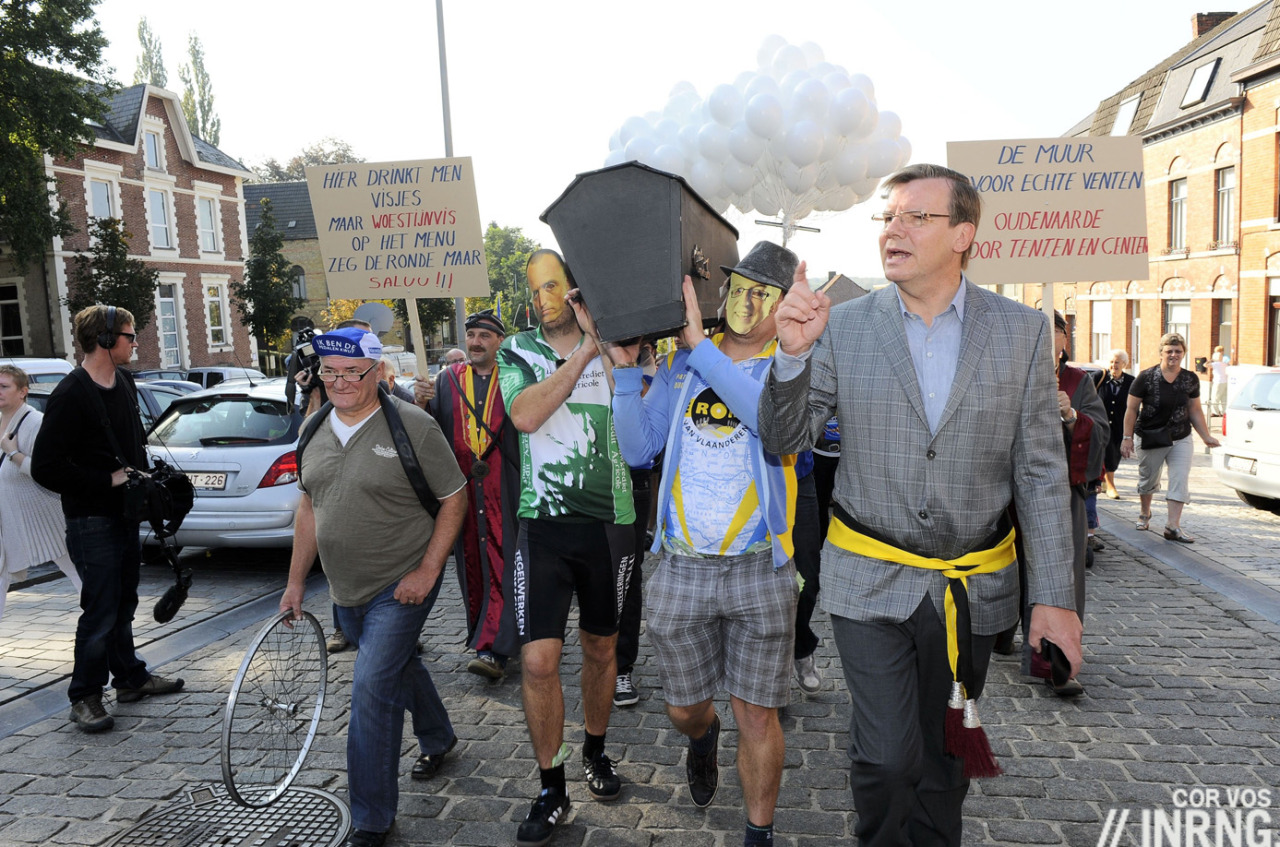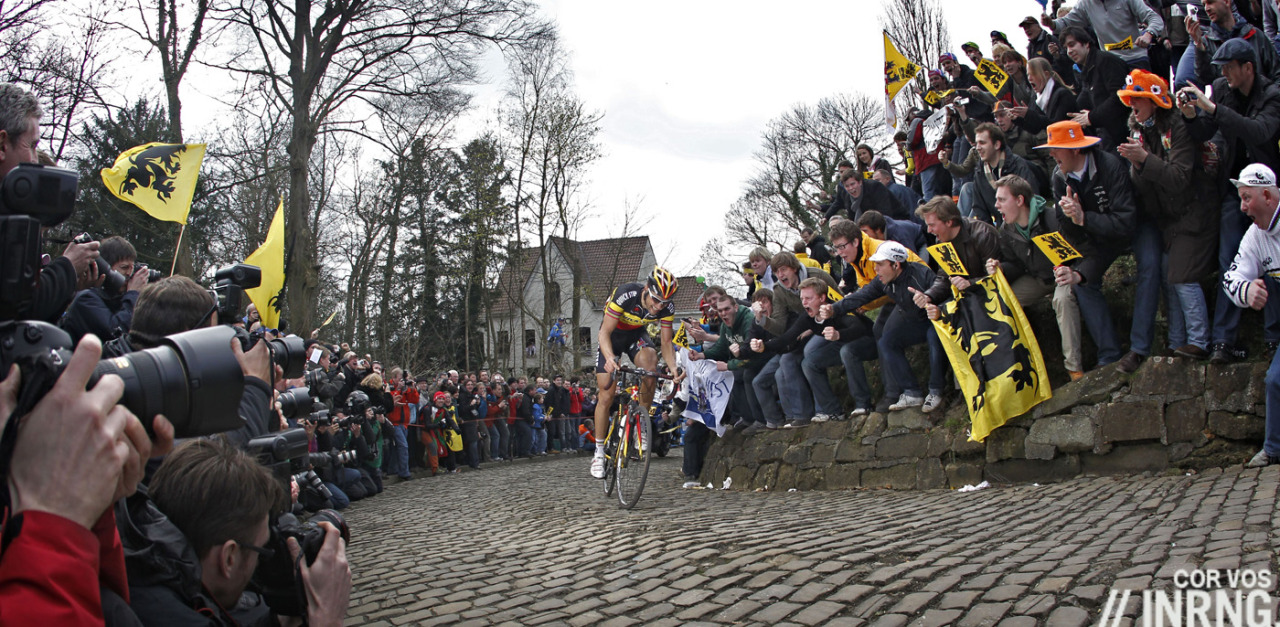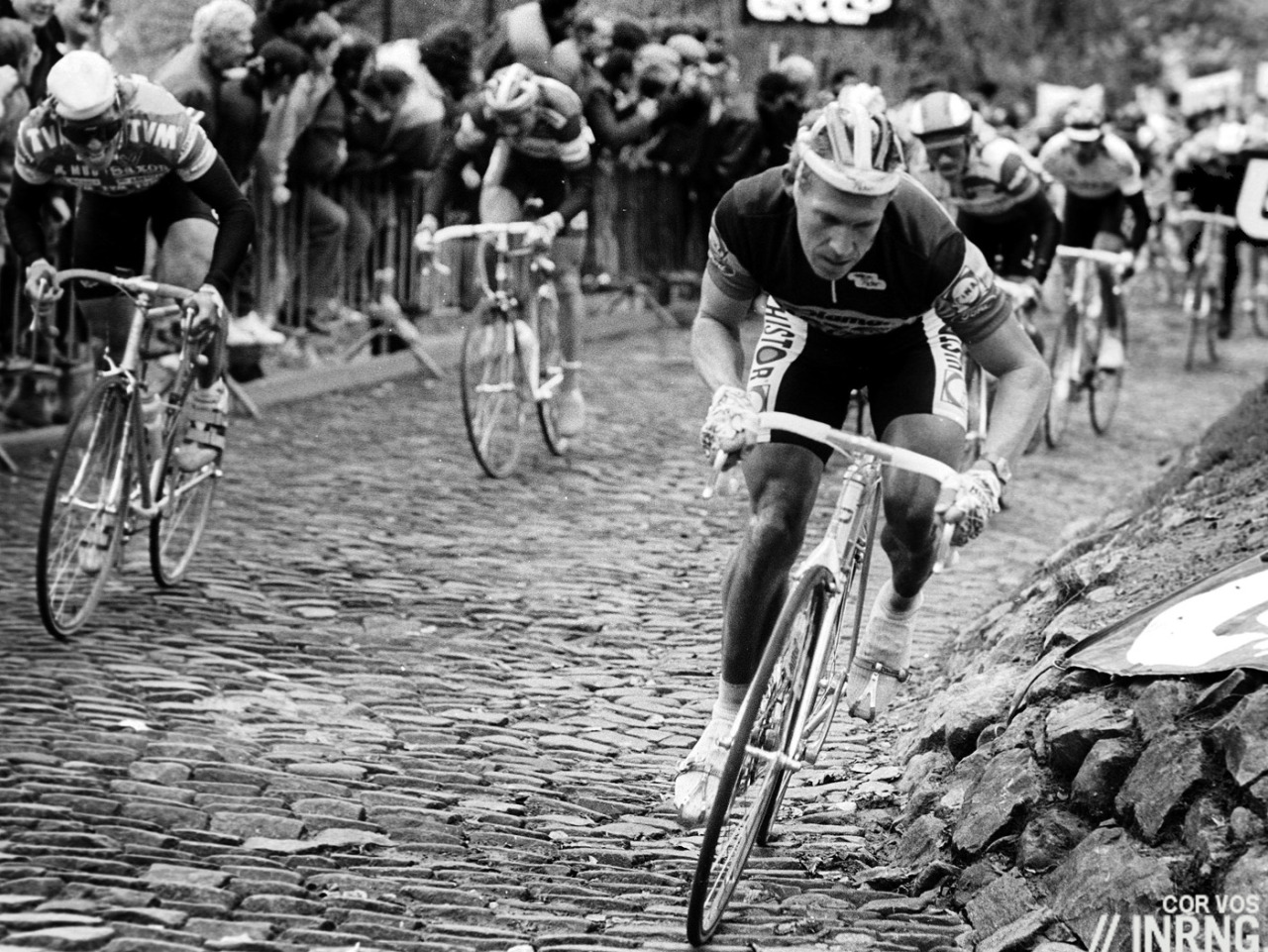This Saturday is openingsweekend and the start of the cobbled classics season with the Omloop Het Nieuwsblad. It’s an old race but a copycat contest too that has found its place on the calendar by constantly frontrunning the Tour of Flanders. So much so that this year’s Omloop poaches the beloved old roads of the Ronde.
It was born out of a backlash. The Tour of Flanders was first run in 1913 and it continued during Belgian’s Nazi occupation between 1940-1944 which was controversial because it relied on military police to secure the route and it was only open to Belgians. It was run by the Het Nieuwsblad newspaper and the wartime editions were seen as acts of collaboration and once the war was over some of the newspaper staff were put on trial. Rival newspaper Het Volk swung into action and created their own race in 1945, the Omloop Van Vlaanderen.
Now for a quick language lesson. Omloop is the local word for a loop, a circuit. Ronde is the word for a round or a tour. They are essentially the same thing and this was half the point of Omloop Van Vlaanderen when it was launched in 1945: a rival newspaper creating a similar race to the Ronde, only untainted by the war.
Omloop vs Ronde? The name was too similar to the Ronde Van Vlaanderen so after various battles the newspaper branded it with its own name and it became the Omloop Het Volk, a name which stuck for decades although the Het Volk and Het Nieuwsblad newspapers were such fierce rivals that Het Nieuwsblad could not bring itself to call the rival race the Omloop Het Volk, labelling it “Gent-Gent” instead. Ironically in 2009 the two newspapers merged and so the Omloop was rebranded the Omloop Het Nieuwsblad. It’s now run under the same roof of Flanders Classics, the Belgian race organiser. Name changes, politics, newspaper rivalry and more, the short version is that the Omloop is the upstart rival to the Ronde.

New for 2018 is the Omloop’s route with the finish in Meerbeke on the outside of Ninove, which comes after the final combo of the Muur van Geraardsbergen and the Bosberg hill. This was the finale of the Ronde up until 2012 when the route was switched over to Oudenaarde and the finish we know today with the laps around the Oude Kwaremont and Paterberg, a financial decision because Oudenaarde paid for it and they can install VIP catering tends alongside the two final climbs whereas the old beer tent in Geraardsbergen was staged out of the races control. The move prompted outrage in Belgium, or at least in a few corners of it. Cycling is a conservative sport – history matters – and there were debates and even a “protest” (read media stunt) on the Muur van Geraardsbergen. For good reason, a Tour of Flanders without the Muur is like a tour of the Pyrenees without the Tourmalet or more appropriately Belgium without beer. The Muur’s absence was felt so much that last year the Ronde went back.

Now the Omloop is resurrecting the famous finish, almost as if again it’s trying to feed off the Ronde’s glorious history: the good old days are back. But it raises the question of whether everything has to stay the same and that to gain validation the Omloop has to go and use the Ronde finish of the past rather than pioneering its own path? Yes and no. Certainly reviving this finish is interesting, the Muur supplied some great moments but that was because it happened in a great race and came after 250km by which point a canal bridge starts to become selective, strategic. Changes happen though the Tour of Flanders itself has changed routes regularly; the Koppenberg was only “discovered” in 1976 meaning the likes of Briek Schotte and Rik Van Looy never raced up it.
The Omloop’s route can change and so can its status. It seems to have gone up in importance of late; it wasn’t long ago that riders fretted about winning the Omloop for fear of going stale by the time the Ronde and Paris-Roubaix came around. It’s joined the UCI World Tour too and if the UCI label isn’t always the guarantee it ought to be, it still marks something.
Finally the Omloop can copy the Ronde for two reasons. First because it’s this Saturday and the start of the cobbled classics meaning there’s a lot of interest and anticipation, perhaps more so than the likes of the Dwars Door Vlaanderen or the GP E3 Harelbeke can muster, they tried the same finish it could look a bit desperate, no? Second because the Omloop and Ronde now share the same organiser meaning the company can afford to spread its assets around the country. If the Omloop will never be the Ronde maybe it can be the next best thing?


Interesting post on the history- thanks very much. Long term reader, first time contributor. I am going to the race for the first time this year.
Anybody advise on where we should go to watch? My plan was to go to Geraardsbergen and sample a few beers before the race zooms by.
Geraardsbergen sounds good, they’ve had big screen TVs in the past in the square below but most bars and cafes will be showing it too.
Thanks so much for the recommendation Mr ENG 😉. I love the website and your posts btw It’s been saving my boring work day mornings for years. Looking forward to a new season of posts and races
RNG*
If i am reading the route PDF correctly if you go to Leberg you will see it 3 times?
Not only the Muur came back in last year’s Ronde, but it proved decisive, too. Not something which would happen any day (or any edition): one of the effects of changing a course can be to generate a certain amount of unpredictability among riders and DSs, which in turn is as likely to produce conservative *or* creative racing. Anyway, it was great to see – and a great narrative for Boonen’s last Flanders.
Memorable images of him leading the attack up the Muur mouth-shut, elbow-tight, bare-handed, sitting abs in & loins back out… while Moscon on his wheels is gasping for air and Kristoff is twisting himself on the bike with a grimace of pain. Cycling handbook.
Just as memorable, the GVA quote: “I think it’s nice to have the Muur back in the parcours, but I don’t think that it will really have a decisive factor. It takes us a little bit out of the way. The parcours from the Muur to Oudenaarde is not really attractive. It’s too early to go for sure, where are you going to go?”. Yeah, where?
However, I usually loved how the old Het Volk finale usually played out, even if I really never knew the race as well as I’d have liked to. That’s why I’m not really convinced by the route switch.
And I’m not sure if the Muur will still work properly as it used to, without the rest of the Flanders before or around it. OTOH, with meaner weather as we tend to have in February, it could prove hellish. What if we get icy roads? Well, interesting experiment. We’ll see.
Re: old Het Volk finale… motorbikes aside, I mean.
Forecast for northern Belgium on Saturday is looking sunny but cold and windy, getting on for very windy. Should be a cracker.
Those delta brakes, mmmm.
I’m happy with this. The old route of the omloop could get pretty dull on the run in.
There’s still a rival newspaper though: Het Laatste Nieuws, IThey called OHN ‘Ghent-Ghent’ for the last couple of years. It seems they’re referring to the race as simply ‘De Omloop’ nowadays. I guess that’s what a WT upgrade also entails, you don’t need to spell out the name in full for people to recognize the race.
Muur or no Muur I think the weather will have a bigger impact than the parcours, it’s going to be barely above O°C with a chilly wind from the East. I think that means headwind for the run-in to Meerbeke, this might dampen the willingness to attack on the Muur but for sure it won’t be a big bunch arriving together.
I’ll continue to call it Het Volk for years. I always liked this social-christian-sounding name. Very appropriate for cycling.
Thanks for this. Even though I don’t think the real season starts until MSR it’ll be damn nice to watch a race with some interesting features, especially compared to jokes like Abu Dhabi.
Interesting how newspapers invented races or heavily contributed to their brand, Het Nieuwsblad, L’Equipe, La Gezzetta Dello Sport etc, to expand readership.
I wonder if the modern equivalent would be the Omloop Youtube or Ronde Instagram. A good opportunity for exclusive broadcasting rights on the organizers platform.
I guess this is already happening to an extent in sports owned by Redbull.
Even worse: “races” on Zwift.
They want content but a peloton crossing big landscapes for hours on end probably isn’t for them, it works on TV but on a phone, maybe it’s not ideal? Newspapers could and do get lots to write about.
With millennials driving the media landscape, and an almost complete merging of TV and internet, I could these races at least being broadcast on a social platform in the next 5-10 years.
Can’t wait. Fridge is well stocked with a selection of Belgian beer.
But alas, I have never been able to find Jupiler in the US!
Beware! Jupiler is to be rebranded and labelled “Belgium” for the next 5 months as a FIFA World Cup marketing move.
Only the 0% alcohol version will be labelled “Jupiler” for the next 5 months.
http://www.xpats.com/jupiler-renamed-belgium-world-cup-marketing-stunt
So thats what is fuelling de Bruyne’s amazing season 😉
Beware of making the wrong choice by picking Jupiler then…
Great post and an example of why this is the best cycling reportage out there. Thanks for sharing a bit of the history that makes the spring races so captivating.
Thanks Mr Inrg for a lovely bit of historical insight – looking forward to the start of the season!
Going to be a cold one though!
here you go Larry T! Time to wake up and smell the racing.
Very interesting thanks and, here’s hoping, exciting once again. A Ronde and a mini Ronde? Is that a bit greedy? Ah well, human nature, let’s be greedy and hope for one and a half Ronde’s every year! 😀
Hi
A little off topic but have you heard any news as to why Sagan is skipping the opening weekend? I thought it would be easy to find news but I came up empty…
Thanks
Some weeks ago the Gazzetta dello Sport wrote that Sagan is going to try and win the Worlds again this Autumn despite the huge change in course style. Well, he’s also saying that he won’t change his prep for that goal – but if you think how different the next Worlds are going to be, it’s unlikely that the same season and training could work again (assuming that the Gazzetta news make sense, which is always sort of a leap of faith).
I really can’t tell if that’s the reason, but it could be, since the pro season is always kind of a jigsaw puzzle where everything must fit – especially if you want to be *fit* at the right time. The last couple of time he skipped the Belgian openers (he raced Strade Bianche, tough), he later went on to ride the Vuelta a España, unlike 2016 and 2017 when he had a way lighter post TdF programme, especially in terms of quality, even if the moto accident at the 2015 Vuelta changed his plans a bit.
Sorry to hi jack this thread but did Tom Boonen just buy shares in Lotto-Soudal?
Yes. How many I don’t know. His manager is Paul de Geyter who recently took over the Lotto-Soudal team with a view to improving it, so there’s an obvious connection.
Ironic that after spending nearly his entire career with Quickstep Terrific Tom’s now owner of its main local rival Lotto. Business is a fickle friend indeed!
As for the Omloop, . . . let the Games begin!
Impacting news, but not *that much* if you think that De Geyter (Lotto Soudal’s TM) opened an Italian restaurant with Tom ^__^
He’s Tom’s former personal manager…
And Tom’s father André has been working at Ridley for a long time, hence I think it really makes sense.
It’s to be seen whether they’ll just use him as a frontman or a – more or less supposed – bike tester, or he’ll also get a taste of how a DS position might work for him. He sure doesn’t need that for a living!
A Lotto Soudal fan just recruited, it looks like he getting his feet under the table, great news for cycling
http://www.cyclingweekly.com/news/racing/lotto-soudal-recruit-tom-boonen-370345
Wow! This is kinda nuts! Now all they have to do is sign Wout !
Thanks for the informative write up – classic INRNG at its individual best.
The weather should play a role, as long as the dreaded ‘bad weather prerogative’ is not invoked.
Is that two Aussies (Neil Stephens and Phil Anderson) in your lead photo inrng?
It’s Anderson for sure with those teeth, the mullet and of course the big Oakleys. The rider in the front is Etienne De Wilde, the “blond arrow of Laarne”. I’ve been reading a lot about the 1989 Tour de France of late and he won a stage, he was a rider capable of “doing the kilometre”, to attack the bunch with 1-2km to go and to stay away for the win, something almost unseen with the sprint trains today.
Well there you go. Good stuff and thanks for the correction.
I’d probably swap my car, house and career for his legs
LOL I defo didn’t think the same exact thing 😉
Since those days it’s been renamed ‘doing a Tchmil’ 😉
I thought it was Edwig Van Hooydonck, it would’ve been appropriate since we’re discussing the Muur-Bosberg-Meerbeke finale. Is that by the way the same Etienne De Wilde who also won countless Six Days events?
De Wilde and Neijdam was a specialist in escaping the sprinter leadout trains in the last 1-2-3km’s, Jesper Skiby was pretty adapt in that decipline too. I actually dont think anyone has mannaged to pull off the trick in the tour since 1993.
Cancellara did it with a late attack in 2008 but had some riders up the road about to get caught which he could aim for and briefly draft off; Rubens Bertogliati too but in an uphill finish so few sprint trains were working. Watching/reading the 1989 Tour it was surprising how many times the sprinters were foiled by this late attack, Nijdam got them too.
Well said about Nijdam. Last km attacks in recent years?
Gaviria at Paris-Tours was incredible – but you referred to the TdF, indeed.
In the last decade or so, I can only recall Stybar in Le Havre, although it was not pan flat at all (suited for the likes of Degenkolb, Kristoff, but also Coquard) and the teams had been disrupted by a fall.
And, yes, I’d count Cancellara in.
It never was easy (it’s not like the riders named above won such stages *that frequently* at the TdF), but it’s become rarer. In recent years, we’re also having more breaks allowed to have their day.
For me, this is the start of the season (with apologies to Larry T for stealing his catchphrase – and choosing the wrong race) – the first race that actually matters, and the first one I bother to watch, after some warming-up. (Note: not an objective fact, just how it is for me.)
I think the new inclusions are a great idea – should make everyone happy: who doesn’t want to see the Muur near the end of a race?
Very good article. Exactly the information I always wanted to know about Het Nieuwsblad but never found anywhere else.
I’d still like to see one of the cobbled races finish on a cobbled hill – something different. That would set DDV apart from the rest.
Etienne De Wilde…… this guy looks like a BEAST!….. anymore info on him? worth a short piece??
what no boonenberg!